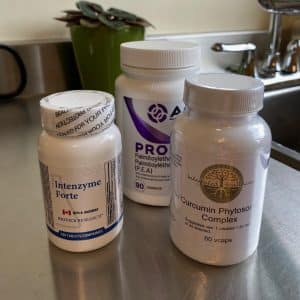Best Pain-Relief Supplements

Common Side-Effects of Advil, Naproxen, and other NSAIDs
I suspect that most of us are grateful that these medications exist. It’s important to use them responsibly and recognize that they come with a cost: These medications can increase blood pressure, harm the kidneys, cause stomach ulcers, and contribute to birth defects if used during pregnancy. Further, these medications not only block “inflammatory pathways”, but also block the “inflammation-resolving pathways” too! This means that using these medications could prolong healing if used inappropriately.
If cold applications work best for pain-relief:
If a healthcare provider has suggested that you ice the painful area, this is often where botanical “anti-inflammatories” and antioxidant supplements are most helpful.
Two popular botanicals (herbs) for pain include Turmeric and Boswellia. Research promotes both as excellent anti-inflammatories, but the key is to choose the one that best matches your Chinese Medicine diagnosis or “health pattern”. Turmeric is a good pick for health concerns that are “dry” or “creaky”, whereas Boswellia is a good match for sensations that are “damp” and cold.* Naturopathic Doctors, Chinese Medicine practitioners, Ayurvedic doctors, or Acupuncturists with training in Chinese Medicine, can help you with this.
If hot applications work best for pain-relief:
If hot feels best and cold feels worse, and if over-the-counter pain pills seem ineffective, you might need to consider something that addresses muscle tension instead. For Naturopathic Doctors, this often includes targeted use of minerals such as calcium or magnesium, or botanicals that promote muscle relaxation, such as passionflower. A Naturopathic Doctor might also want to explore whether vitamin D deficiency, dehydration, or chronic stress are contributing to this kind of pain. Approaches that improve circulation, such as proteolytic enzyme therapy, red light therapy, and hydrotherapy, might also be recommended.
The Big Picture
Botanicals and supplements can be used as band-aids, or they can be applied with skill to help the body heal and treat the underlying cause. For complex pain conditions, it’s so important to enlist the help of a skilled manual therapist and/or holistically-minded practitioner to explore the role of contributing factors like the gut-brain axis, neuroplasticity, and hormones.
*As always, please be mindful that these botanical medicines DO have their own capacity to create side-effects and can be used inappropriately. Some drugs also interact with these botanicals and not all preparations are created equally despite approval by Health Canada. Please consult a knowledgeable healthcare provider before trying these products.
Additional Resources:
Integrative Chronic Pain program at KIHC
Pain Reprocessing Therapy at KIHC (i.e. using neuroplasticity to address pain)
What’s the Best Time of Day to Take Pain Medication?
Chronic Pain: Top 10 for Recovery
The Big Three to Relieve Low Back Pain
References:
Chen X, Yang Y, Chen L, Wang K. Pregnancy outcomes and birth defects in offspring following Non-steroidal anti-inflammatory drugs exposure during pregnancy: A systematic review and meta-analysis. Reproductive Toxicology. 2024;125:108561. doi:https://doi.org/10.1016/j.reprotox.2024.108561
Sugimoto MA, Sousa LP, Pinho V, Perretti M, Teixeira MM. Resolution of Inflammation: What Controls Its Onset? Front. Immunol. April 2016;7. doi:10.3389/fimmu.2016.00160.